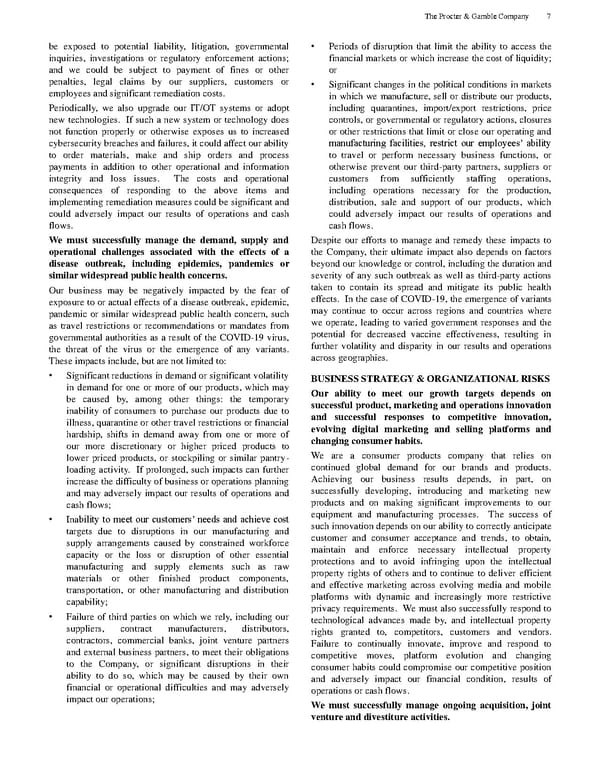be exposed to potential liability, litigation, governmental inquiries, investigations or regulatory enforcement actions; and we could be subject to payment of fines or other penalties, legal claims by our suppliers, customers or employees and significant remediation costs. Periodically, we also upgrade our IT/OT systems or adopt new technologies. If such a new system or technology does not function properly or otherwise exposes us to increased cybersecurity breaches and failures, it could affect our ability to order materials, make and ship orders and process payments in addition to other operational and information integrity and loss issues. The costs and operational consequences of responding to the above items and implementing remediation measures could be significant and could adversely impact our results of operations and cash flows. We must successfully manage the demand, supply and operational challenges associated with the effects of a disease outbreak, including epidemics, pandemics or similar widespread public health concerns. Our business may be negatively impacted by the fear of exposure to or actual effects of a disease outbreak, epidemic, pandemic or similar widespread public health concern, such as travel restrictions or recommendations or mandates from governmental authorities as a result of the COVID - 19 virus, the threat of the virus or the emergence of any variants. These impacts include, but are not limited to: • Significant reductions in demand or significant volatility in demand for one or more of our products, which may be caused by, among other things: the temporary inability of consumers to purchase our products due to illness, quarantine or other travel restrictions or financial hardship, shifts in demand away from one or more of our more discretionary or higher priced products to lower priced products, or stockpiling or similar pantry - loading activity. If prolonged, such impacts can further increase the difficulty of business or operations planning and may adversely impact our results of operations and cash flows; • Ina bility to meet our customers’ needs and achieve cost targets due to disruptions in our manufacturing and supply arrangements caused by constrained workforce capacity or the loss or disruption of other essential manufacturing and supply elements such as raw materials or other finished product components, transportation, or other manufacturing and distribution capability; • Failure of third parties on which we rely, including our suppliers, contract manufacturers, distributors, contractors, commercial banks, j oint venture partners and external business partners, to meet their obligations to the Company, or significant disruptions in their ability to do so, which may be caused by their own financial or operational difficulties and may adversely impact our operat ions; • Periods of disruption that limit the ability to access the financial markets or which increase the cost of liquidity; or • Significant changes in the political conditions in markets in which we manufacture, sell or distribute our products, including qu arantines, import/export restrictions, price controls, or governmental or regulatory actions, closures or other restrictions that limit or close our operating and manufacturing facilities, restrict our employees’ ability to travel or perform necessary busi ness functions, or otherwise prevent our third - party partners, suppliers or customers from sufficiently staffing operations, including operations necessary for the production, distribution, sale and support of our products, which could adversely impact our results of operations and cash flows. Despite our efforts to manage and remedy these impacts to the Company, their ultimate impact also depends on factors beyond our knowledge or control, including the duration and severity of any such outbreak as well as third - party actions taken to contain its spread and mitigate its public health effects. In the case of COVID - 19, the emergence of variants may continue to occur across regions and countries where we operate, leading to varied government responses and the potential for decreased vaccine effectiveness, resulting in further volatility and disparity in our results and operations across geographies. BUSINESS STRATEGY & ORGANIZATIONAL RISKS Our ability to meet our growth targets depends on successful product, marketing and operations innovation and successful responses to competitive innovation, evolving digital marketing and selling platforms and changing consumer habits. We are a consumer products company that relies on continued global demand for our brands and products. Achieving our business results depends, in part, on successfully developing, introducing and marketing new products and on making significant improvements to our equipment and manufacturing processes. The success of such innovation depends on our ability to correctly anticipate customer and consumer acceptance and trends, to obtain, maintain and enforce necessary intellectual property protections and to avoid infringing upon the intellectual property rights of others and to continue to deli ver efficient and effective marketing across evolving media and mobile platforms with dynamic and increasingly more restrictive privacy requirements. We must also successfully respond to technological advances made by, and intellectual property rights gra nted to, competitors, customers and vendors. Failure to continually innovate, improve and respond to competitive moves, platform evolution and changing consumer habits could compromise our competitive position and adversely impact our financial condition, results of operations or cash flows. We must successfully manage ongoing acquisition, joint venture and divestiture activities. The Procter & Gamble Company 7
 The Procter & Gamble Annual Report Page 18 Page 20
The Procter & Gamble Annual Report Page 18 Page 20